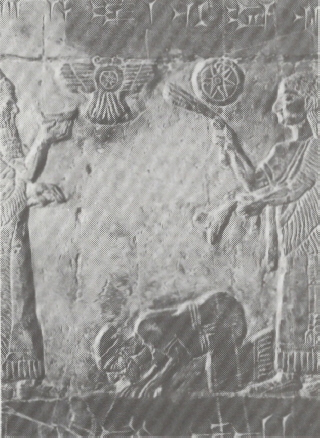Assyrian Brutality -- By: Bob Boyd
Journal: Bible and Spade (Second Run)
Volume: BSPADE 03:2 (Spring 1990)
Article: Assyrian Brutality
Author: Bob Boyd
BSP 3:2 (Spring 1990) p. 61
Assyrian Brutality

King Jehu of the Northern Kingdom, paying tribute to Shalmanezer—on the Black Obelisk. This is the only representation of a Hebrew king ever discovered.
The Assyrian Kingdom became one of Israel’ s mightiest, most brutal foes. It was a nation with the highest culture, a highly formal religion, and skilled in the crafts and arts of mankind, but was unmercifully cruel in its punishment of its enemies. Their acts were atrocious. King Ashurnasirpal (883–859 BC) was its great leader of expansion. His armies of bowmen, spearmen, slingers, cavalry and charioteers made up one of the most feared and dreaded units of military might of that day. Such was what the prophet Nahum had in mind (Nah 2:3, 4; 3:2, 3). Ashurnasirpal described his dealings with a certain city he had conquered as follows: “Six hundred of their warriors I put to the sword; 3000 captives I burned with fire; I left not a single one among them alive to serve as a hostage. Kholai, their governor, I captured alive. Their corpses I piled into heaps; their men and maidens I burned in the fire; Khulai, their governor, I flayed and his skin I spread upon the wall of the city of Damdamusa; the city I destroyed, I ravaged, I burned with fire.”1
Ashurnasirpal set the pace of cruelty for his successors, although some were content to take prisoners and make the defeated king (nation)pay tribute. Jehu, king of the Northern Kingdom of Israel, had a confrontation with king Shalmaneser III ca. 841 BC. Discovered in the ruins of his palace at Calah (Nimrud) was what is called “The Black Obelisk.” This monument shows five officials of different nations paying tribute to this king, one of whom is Jehu. The record mentions “Tribute of Jehu, son [or descendant] of Omri, gold silver, golden goblets and pitchers, golden vases and vessels, scepters from the hand of the king, javelins I received from him.” This obelisk, six and one-half feet tall, bears the only contemporary likeness that had ever been found of an Israelite king.2
In spite of Shalmaneser’ kindness in accepting tribute, one of his records, carved on the side of the old Assyrian Pass in Lebanon, states that he is “The legitimate King, King of the Universe, the King without rival, the ‘great Dragon,’ the only power with the four rims of the whole world who smashed all his foes like pots.”
Another king is worthy of mention, a “f...
Click here to subscribe
